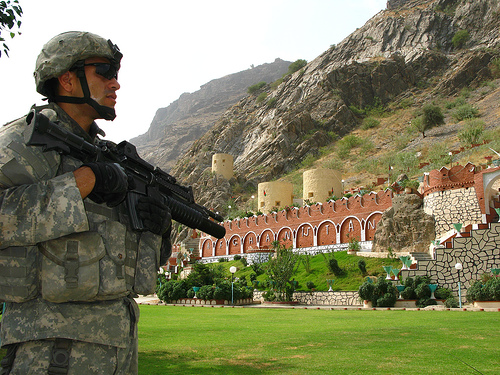
Many decades ago, cowboy actor-singer Gene Autry made famous the tune, “Don’t Fence Me In.” Today, in the diaphanous territory between Afghanistan and Pakistan, a better song could well be “Please fence me in.” Indeed, that may be one of the few alternatives left if that region is ever to be stabilized and made more peaceful.
Pakistan is in the midst of multiple existential crises over security, its economy and now dealing with the super floods that still continue to inflict tragedy and ruin on that nation. But, in Islamabad, despite the countless checkpoints and armed police and military in clear sight, the sense of urgency in coping with these crises and massive scale of suffering is difficult to detect. Perhaps that mood is reflective of the dilemmas and paradoxes that probably will limit the amount of foreign aid and assistance Pakistan so desperately needs from being sent.
In the United States, the Obama administration understands the extent of this humanitarian catastrophe and the possible geostrategic consequences. However, pragmatism and cynicism are also evident. The White House does not hold the Pakistani civilian government in high regard. As a result, President Obama has still not spoken with Pakistani President Asif Ali Zardari although Vice President Joe Biden did call Prime Minister Yousaf Raza Gilani six weeks into the floods to express support.
The administration believes that the Army, despite its high institutional standing among the Pakistani people, is not controlled by the civilian leadership. And Inter-Services-Intelligence (ISI) is still seen as operating independently and not always in concert with the best interests of the United States and its allies fighting in Afghanistan. Furthermore, given the state of the American economy and the mood in Congress, the White House concludes that U.S. largesse is limited.
Last year, the Kerry-Lugar-Berman Act appropriated $7.5 billion over five years in aid for Pakistan. Yet, no funds have been transferred yet, in large measure because the U.S. is rightly worried about how that money will get to intended users and not the pockets of intermediaries, realities Pakistanis find offensive. Another billion or so dollars is used for annual coalition support funding to underwrite Pakistani Army operations. So the American golden goose, in the eyes of the administration, has run out of eggs.
The major advocates for Pakistan have been UN Secretary General Ban Ki-Moon who has visited Pakistan, seen the extent of the cataclysm and been a force for good in trying to rally the international community to come to Pakistan’s aid. And the European Union, spurred on by British Prime Minister David Cameron, has finally lifted temporarily textile tariffs on Pakistani cotton goods even though it is uncertain when the next cotton crops will occur given the flood damage. Unfortunately, the United States has not been able to do the same, lifting its tariffs.
Interestingly, given American ineptitude in dealing with Hurricane Katrina, it is surprising that the White House seems to expect more from Pakistan’s far less capable government in coping with these crises. Given that the Pakistani civilian government cannot change the image or reality of its competence overnight and the Obama administration has self-imposed limitations of what it can and cannot do to help, are there any alternatives beyond muddling through?
Aside from the humanitarian disaster, the main U.S. interest in the region is stability. As argued before in this column, success no matter how defined in Afghanistan cannot be achieved without Pakistan. A major contention has been the border between the two states and allegations and evidence of sanctuaries in Pakistan used by Taliban and other insurgents as well as ease of cross-border transit. Why not then consider building a high technology, well-manned and monitored barrier well on the Pakistan side of the Durand line to prevent or reduce this traffic?
That border is some 1500 miles in length. But only 300 or so miles between Peshawar and the northern tip of Baluchistan are most critical. Americans will argue that fences do not work no matter high tech, citing our own border with Mexico and the flood of illegal immigrants and drugs that have not been checked.
On the other hand, barriers worked in Baghdad and Israel where terror attacks were greatly reduced as well on the Indian side of the Kashmir border—and sadly divided Berlin for over forty years— if properly manned and designed using the latest sensor and surveillance technology. And Pakistan does have nearly 150,000 troops on its border with Afghanistan in some 850 outposts to ensure that any barrier does indeed work.
The potential of such a barrier must be carefully examined from every strategic, political, economic and social direction. But, it may well be that “please fence me in” is a sound and given the circumstances, our best option.
Harlan Ullman is Senior Advisor at the Atlantic Council, Chairman of the Killowen Group that advises leaders of government and business, and a frequent advisor to NATO. This article was syndicated by UPI. Photo credit: U.S. Army Flickr.
Image: 1267940705_5dd6e3c150.jpg
